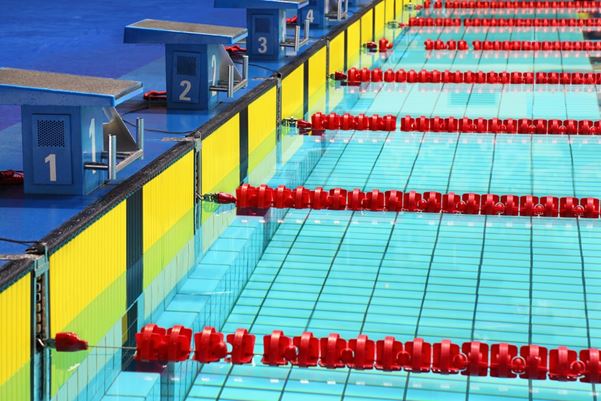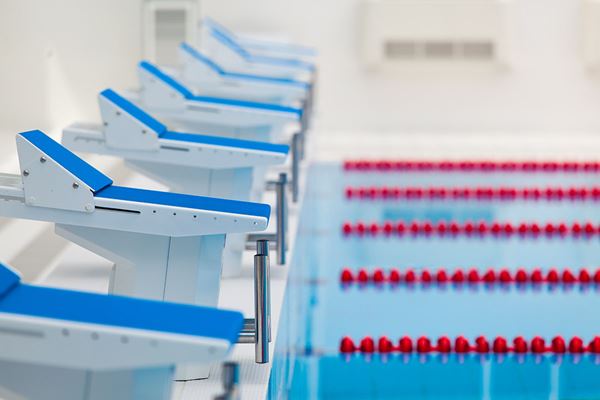It was a close call. Everyone on the US team witnessed USA swimmer Lance Larson come from behind and finish strong for what appeared to be a victory in the 100 meter freestyle. All three official timekeepers for his lane had him clocked at a faster time than Australian John Devitt. But the finish judges, who relied only on their eyes in an era when there were no camera instant replays, decided that the gold medal should go to Devitt. An outcry of shock and protest ensued. This 1960 Summer Olympics finish in Rome was one of the most controversial Olympic swimming finishes ever.
History of Touchpads for Swimming Pools
The controversial finish of 1960 was a catalyst for encouraging the commercialization of Bill Parkinson’s recently successful 1957 invention, the touchpad. These touchpads allowed swimmers to stop the clock with their own hand, reducing the manual poolside timekeepers to “back-up” status. As a professor of physics at the University of Michigan, Bill wanted to solve two problems: human error during timing as well as a very crowded swimming deck. There could be as many as 33 people judging, timing and refereeing on the pool deck at one time. With three timers assigned to a lane, each swimmer was at the mercy of an averaged time of all three stopwatches. That meant even if a time-keeper was splashed, blocked, or just had really terrible reflexes, their time was still part of the equation. And as we learned from the 1960 event in Rome, judges could still ultimately overrule the clock. Despite the unenviable challenges of manual timing, coaches were still opposed to using touchpads until that contentious Olympic day. By 1962, two years after the controversial Olympic finish, the NCAA approved the use of touchpads for all swimming competitions. However, it wasn’t until 1968 in Mexico City that they made their Olympic debut. Touchpads have been used at every Olympics since and in all major swimming competitions.
The Technology Behind Touchpad for Swimming
Ähnliches Produkt:
Ever wonder about the technology behind the touchpad? Parkinson’s original design was crude at best but was still successful enough to convince the University of Michigan to implement them years before they gained national acceptance. Parkinson basically developed an early variation of the pressure sensor. His prototype consisted of a rubber pouch with copper wires sewn in that was then filled with insulating silicone oil. The copper wires were connected to a timer. When the rubber pouch was compressed the copper wires flexed. This flexing caused a change in resistance that triggered the timer to stop the clock. It was simple but very effective.
Ähnliches Produkt:
One major obstacle for Parkinson was designing his touchpad to be able to withstand the challenges of being in water. Although IP ratings were not yet invented, he knew there would be safety concerns with swimmers continuously slamming their hands into a bag full of electricity. In addition, he needed the contraption to register a time even if the swimmer touched the wall above the water line. Because silicone oil has a lower density than water, his device was able to slightly float when submerged in the pool, allowing both above and below water touches to successfully be detected. One hurdle Parkinson didn’t entirely overcome was the random detection that sometimes occurred with big splashes or waves. The solution would come just a few years later in 1962 when the watch company, Omega, started production of a newer upgraded touchpad. Their breakthrough came as a sensor that could accurately detect contact by a human hand while remaining unaffected by splashing waves. Touchpads were finally reliable enough for widespread use.

Evolution of Touchpad Technology Design
Today’s ultra-thin touchpads have come a long way from the rubber pouch of 1957. But the science behind how they work remains the same. Modern touchpads are slim and portable so they can be removed after a meet. Typically they consist of a stainless steel frame and a non-slip surface material such as PVC plastic slats or textured vinyl. They must be both reliable and durable, able to resist long term exposure to hard water and chemical corrosion from chlorine. The guts of the touchpad have vastly improved since the silicone oil and copper wire of the early prototype. Internal contact strips close when at least 4 lbs. of localized pressure are applied anywhere on the pad. The design allows for a highly sensitive touchpad that can detect the contact of a single fingertip, yet it ignores overall surface pressure changes. This eliminates false timing signals from splashes and waves.
Advantages of Touchpad Technology
Beyond the finish, in a sport where timing is everything, the start of the race is the other main point of contention in swimming. The same touchpad technology used in the pool is now also built into the starting blocks. Engineers studied every aspect of the starting block—from the optimal angle to the most ideal non-slip materials. Then in the 2012 London Olympics they introduced revolutionary starting blocks which incorporated imbedded contact strips sensitive to the weight of the swimmer. Judges no longer have to visually monitor whether a swimmer leaves the block early during a start or relay. Once again external factors are removed from the equation with an automatic and reliable system that can easily determine the difference between an amazingly explosive start and a false start.

Though advancements in technology are sometimes accused of changing a sport for the worse, in swimming it has allowed the sport to rise above any risk for human error or subjective judgment. What’s left is pure competition, where there is no question who gets to take home the Gold.




